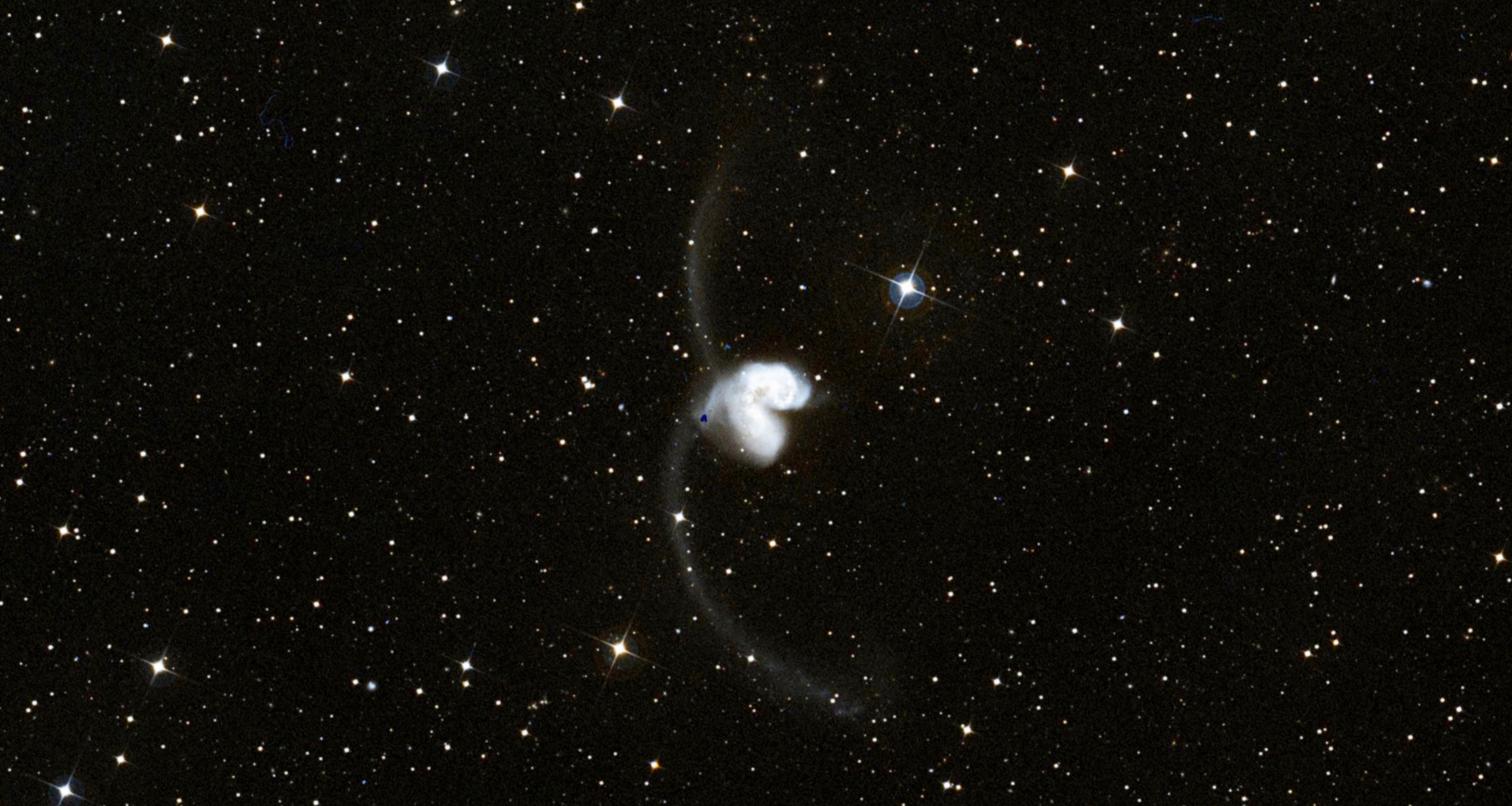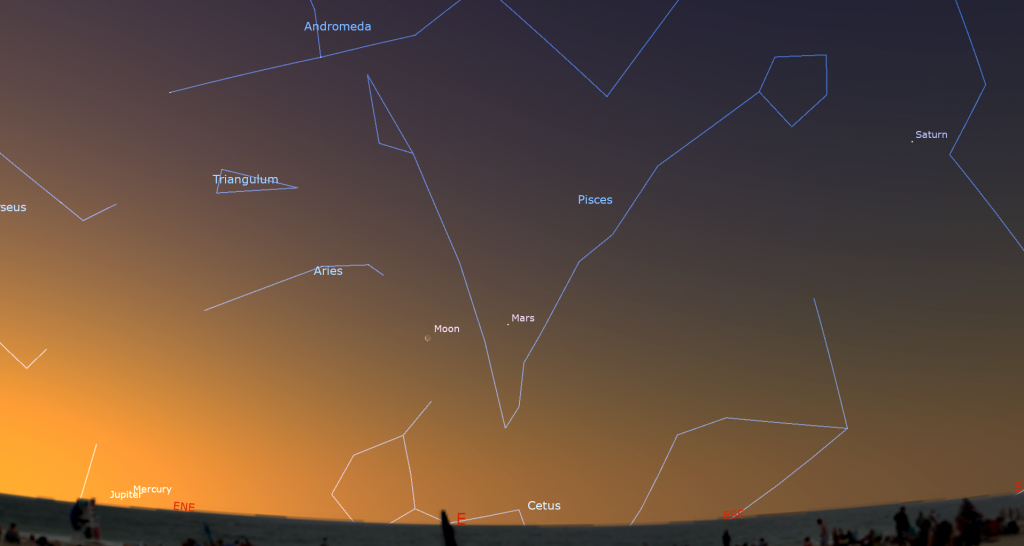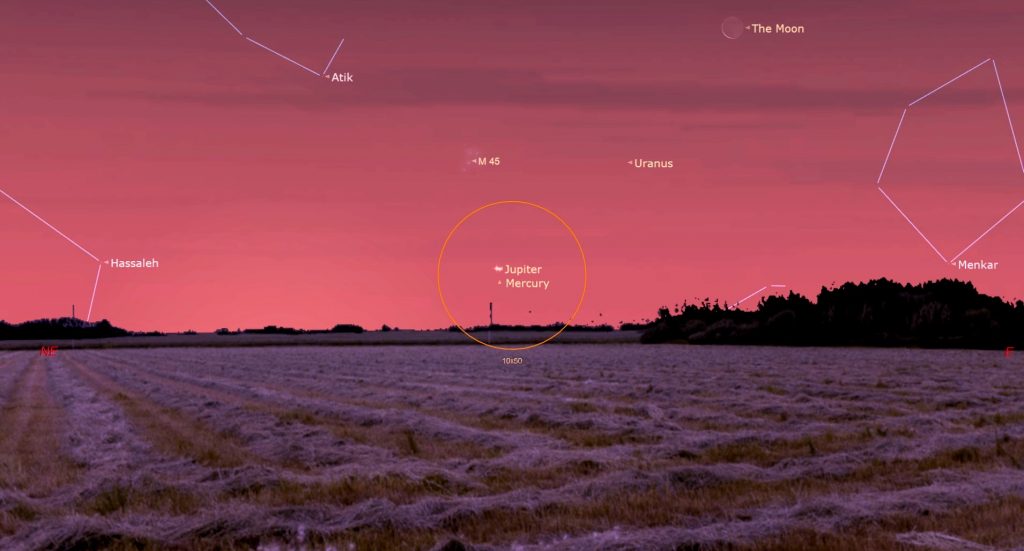A Mini Morning Planet Parade, and the Absent Moon Lets Us See Spring Galaxies and Some Small Comets!

This Digital Sky survey image shows the Antenna Galaxies aka NGC 4038, 4039 in the constellation of Corvus, which shines brightly in the lower part of the southern sky on early June evenings. The bright segments are the cores of two galaxies in the process of merging by mutual gravitational attraction. Curved streams of stars forming the “antennae” extend up and down from the cores. This image from Stellarium spans about the size of the full moon in the sky.
Hello, Start-of-June Stargazers!
Here are your Astronomy Skylights for the week of June 2nd, 2024 by Chris Vaughan. Feel free to pass this along to your friends and send me your comments, questions, and suggested topics. You can also follow me on Twitter as @astrogeoguy! Unless otherwise noted, all times are expressed in Eastern Time. To subscribe to these emails please click this MailChimp link.
If you’d like me to bring my Digital Starlab portable inflatable planetarium to your school or other daytime or evening event in Simcoe, Grey, and Bruce Counties, or deliver a virtual session anywhere, contact me through AstroGeo.ca, and we’ll tour the Universe, or the Earth’s interior, together! My book with John A. Read entitled 110 Things to See With a Telescope is a guide to viewing the deep sky objects in the Messier List – for both beginners and seasoned astronomers. DM me to order a signed copy!
The moon will be passing the sun this week, so it will start the week as an old crescent in the east in morning and end it as a young crescent in the west in evening. Meanwhile it will pose above Jupiter. Moonless nights allow us to see more stars, leftover spring galaxies, and a couple of small comets. Mars and Saturn will lead the planet parade from the wee hours until dawn. Read on for your Skylights!
Aurorae!
The active region on the sun that produced the terrific aurorae show on May 10 has made its way all around the sun and recently returned to view from Earth, setting up the possibility of another night of green and pink dancing lights. Already it has emitted a series of strong flares. If the material ejected from a flare intersects Earth’s orbit while we are there a few days later, it will trigger a geomagnetic storm and aurorae.
Add to this that the moon will be out of the night sky for the coming week (as it was last month) and we have the makings of another fine show. All we need are cloud-free skies. If you can get away from the urban light pollution, you’ll see more.
Watch social media. If you see photos of aurorae coming from Europe, then North America is likely to get aurorae when darkness falls hours later. Fingers crossed!
The Moon
The moon will give everyone on Earth one more week of dark nights. Our natural satellite will slide nearer to the sun in the pre-dawn sky until Wednesday. After it passes the sun on Thursday morning, the moon will return to visibility in the western sky after sunset for the rest of the week. Luckily for stargazers – its slim crescent will set in the west by the time the sky darkens.
In the eastern sky before dawn tomorrow (Monday) morning, the pretty, old crescent moon will shine a palm’s width to the left (or celestial ENE) of the reddish planet Mars. Mars will rise to join the moon after about 4 am and then remain visible until the brightening sky hides the planet. Observers viewing their meet-up from westerly time zones will see the moon close enough to Mars for them to share the view in binoculars.
The even slimmer moon will rise in a twilit sky on Tuesday morning. Before sunrise on Wednesday morning, the then only 1.7% illuminated crescent moon will be positioned several finger widths higher than Jupiter and Mercury above the east-northeastern horizon. Jupiter will clear the horizon by about 5 am local time, followed by Mercury about 5 minutes later. Binoculars will show the moon and two planets in the same field of view. If you live closer to the tropics where the ecliptic will be vertical, they’ll all be easier to see. Keep an eye out for the stars of the Pleiades Cluster aka The Seven sisters and Messier 45 positioned just above the moon, too. Turn all optical aids away from the eastern horizon before the sun rises.
That will be our last chance to see the moon in the morning this week. On Thursday, June 6 at 8:38 am EDT, 5:38 am PDT, or 12:38 Greenwich Mean Time, the moon will officially reach its new moon phase. At the new phase our natural satellite will be located in Taurus (the Bull), and about 4 degrees north of the sun. While new, the moon is travelling between Earth and the sun. Since sunlight can only shine on the far side of the moon, and the moon is in the same region of the sky as the sun, it becomes completely hidden from view from anywhere on Earth for about a day.
By the time the sun sets on Thursday evening (at about 9 pm local time at the latitude of Toronto), the young crescent moon will be lurking above the western horizon. To more easily see it, though, wait until Friday, when it will sport a very slender crescent in a bright sky.
As the sky is darkening after sunset on Saturday, look for the slim crescent of the young moon shining prettily in the lower part of the western sky below the “fraternal twin” stars of Gemini . They will appear side-by-side above the moon with Pollux (on the left) and Castor (on the right). The bright white star Procyon will sparkle down to the moon’s lower left and bright yellowish Capella will gleam to the moon’s lower right. Tracing the connections between those four bright stars will form the Arch of Spring, an asterism that appears in the west every evening at this time of year at mid-northern latitudes. Skywatchers located in westerly time zones will see the moon closer to Pollux.
The waxing crescent moon will end this week shining among the faint stars of Cancer (the Crab) until about midnight, when they will all set in the west. Next weekend onwards will be the best moon-viewing period of the month.
The Planets
The much overhyped “parade of planets” will continue in the eastern sky every morning before sunrise. Don’t make a special trip outside at the crack of dawn to see it. Of the five bright planets we are able to see with unaided eyes from Earth at various times (namely, Mercury, Venus, Mars, Jupiter, and Saturn, only Mars and Saturn will be readily observable because they are rising while the sky is still dark. Bright Jupiter will rise only 20 minutes before the sun, but it will be very hard to see unless you live near the tropics.

If you are willing to set the alarm and head out on a clear morning, the medium-bright, yellowish dot of Saturn will rise around 2 am local time and then clear the rooftops in the east about an hour later. Reddish Mars will rise by 3:30 am. Mars will shine a little brighter than Saturn. Far fainter, blue Neptune will be located about two-thirds of the distance along the line connecting Saturn and Mars, i.e., a fist’s diameter to the lower left (or 11° to the celestial east) of Saturn. This year, Neptune will be positioned a bit more than a thumb’s width to the upper left of a medium-bright star named 27 Piscium. They’ll share the view in binoculars. Other less-brilliant stars nearby named 29 Piscium, 24 Piscium, and 20 Piscium will help guide you to Neptune with a backyard telescope or good, strong binoculars.
Saturn’s rings, which will effectively disappear when they become edge-on to Earth next March, already appear as a very narrow slash across the planet’s globe. Good binoculars can hint at Saturn’s rings and any telescope will show them. For telescope-owners, Earth’s perspective of the Saturn system this year and next will produce frequent transits of Saturn’s moons and their black shadows across its disk. In a telescope, Mars’ position on the far side of the sun from Earth will keep the planet looking like a small, rusty disk.
The slanted ecliptic, which expresses the plane of our solar system across the sky, is keeping all the planets low in the morning sky. As we get closer to the June solstice, the ecliptic will become more vertical and lift the planets higher. Moreover, everything is rising about half an hour earlier per week due to our orbit around the sun. Saturn will start rising before midnight on July 7, and Jupiter will join the evening sky from September 4 onwards. Like Saturn, Neptune will be a star-party target from late summer on.
As for the other planets in the parade, Venus will be completely out of sight while it crosses beyond the sun on Tuesday. It’ll gradually emerge into view as the “Evening Star” after mid-summer. Uranus will be positioned twice as far from the morning sun as Jupiter, but that that distant planet isn’t nearly bright enough to outshine the bright sky around it.

On the mornings surrounding Tuesday, June 4, speedy Mercury’s trip sunward will carry it extremely close to Jupiter. The two planets will shine above the east-northeastern horizon just before sunrise. Their separation will be narrow enough for them to share the view in binoculars or a small telescope from Monday to Wednesday, with Mercury positioned above twice as bright Jupiter on Monday and then below it on Wednesday. During their closest approach on Tuesday, they’ll be a mere 0.2 degrees apart. The conjunction will be difficult to see against the bright sky. Observers in the tropics will have an easier time seeing the duo, especially around 6 am local time. Be sure to turn all optical aids away from the eastern horizon before the sun rises.
A Telescope Comet Alert
For my friends who have telescopes, a comet named C/2023 A3 (Tsushinshan-Atlas) is currently visible during much of the night in western Virgo (the Maiden). Thanks are due to my friend Tom Luton, who is also the president of RASC Toronto Centre. He alerted me to it while we both had our telescopes out on Friday night, and I took a peek.

The comet is already halfway up the southwestern sky after dusk and descending to set around 2:45 am local time, so you’ll want to view it as soon as the sky gets completely dark after 10 pm. This week the comet will be travelling left to right (or eastward) above the bright double star Zavijava (aka Beta Virginis) which forms part of the maiden’s lower arm. What I saw in my big telescope was a cute little mini-comet – glowing head (or coma) with a point of light glowing within and a short tail fanning out narrowly sideways.

At the moment the comet has a brightness of magnitude 10-ish. The math says that this comet will become magnitude 1.0, bright enough to see with unaided eyes, before dawn in late October. Let’s hope!
By the way, another comet named 13P/Olbers is available to view low in the western sky after dusk. This periodic comet, which might be spotted in binoculars, is travelling upward (or celestial east) between the bright stars Castor and Menkalinan. In other words, it’s slicing through the Arch of Spring asterism that I described above, making it easy to locate.

Taking a Boo at Boötes
If you missed last week’s tour of Boötes (“Bow-OH-tees”), the Herdsman or Ploughman, I posted it with sky charts and pictures here.
Public Astronomy-Themed Events
Every Monday evening, York University’s Allan I. Carswell Observatory runs an online star party – broadcasting views from four telescopes/cameras, answering viewer questions, and taking requests! Details are here. They host in-person viewing on the first clear Wednesday night each month. Other Wednesdays they stream views online via the observatory YouTube channel. Details are here.
On Wednesday evening, June 5 at 7:30 pm EDT, the RASC Toronto Centre will host their free, public, in-person monthly Recreational Astronomy Night Meeting in the Loft at the Ontario Science Centre. The meeting will also be live streamed at https://www.youtube.com/rasctoronto/live. Talks will include The Sky This Month and several reports on the recent solar eclipse. Details are here.
On Friday morning, June 7 from 10 am to noon EDT, head to the David Dunlap Observatory for in-person DDO Sun Fun. Safely observe the sun with RASC Toronto astronomers! During the session, which is for ages 5 and up and runs rain or shine, a DDO Astronomer will answer your questions about our closest star – the sun! Registrants will learn how the sun works and how it affects our home planet, view the sun through solar telescopes, weather permitting, and visit the giant 74” telescope. More information is here and the registration link is at ActiveRH.
On Friday afternoon, June 7 from 1 to 3 pm EDT, head to the David Dunlap Observatory for DDO Space Action: Craters and Comets! During the session, which is for ages 5 and up and runs rain or shine, the David Dunlap Observatory Astronomers will explore some of the dynamic action of space through comets, craters, and more! Participants will learn about comet composition and impact craters through interactive demonstrations. They will create and name their own crater and leave with a map of the moon’s craters and other features. Materials will be provided. Adult participation is required, limited to one adult per child. More information is here and the registration link is at ActiveRH.
On Saturday, June 8 from 10 am to noon, you can try out Solar Observing at the Ontario Science Centre! If it’s sunny, members of the RASC Toronto Centre will be setting up outside on the Teluscape in front of the main doors. They’ll have an array of special equipment designed to view the Sun safely. This is free to the public, but parking and admission fees inside the Science Centre will still apply. Check the RASC Toronto Centre website or their Facebook page for the Go or No-Go notification.
Keep your eyes on the skies! I love getting questions and requests. Send me some!